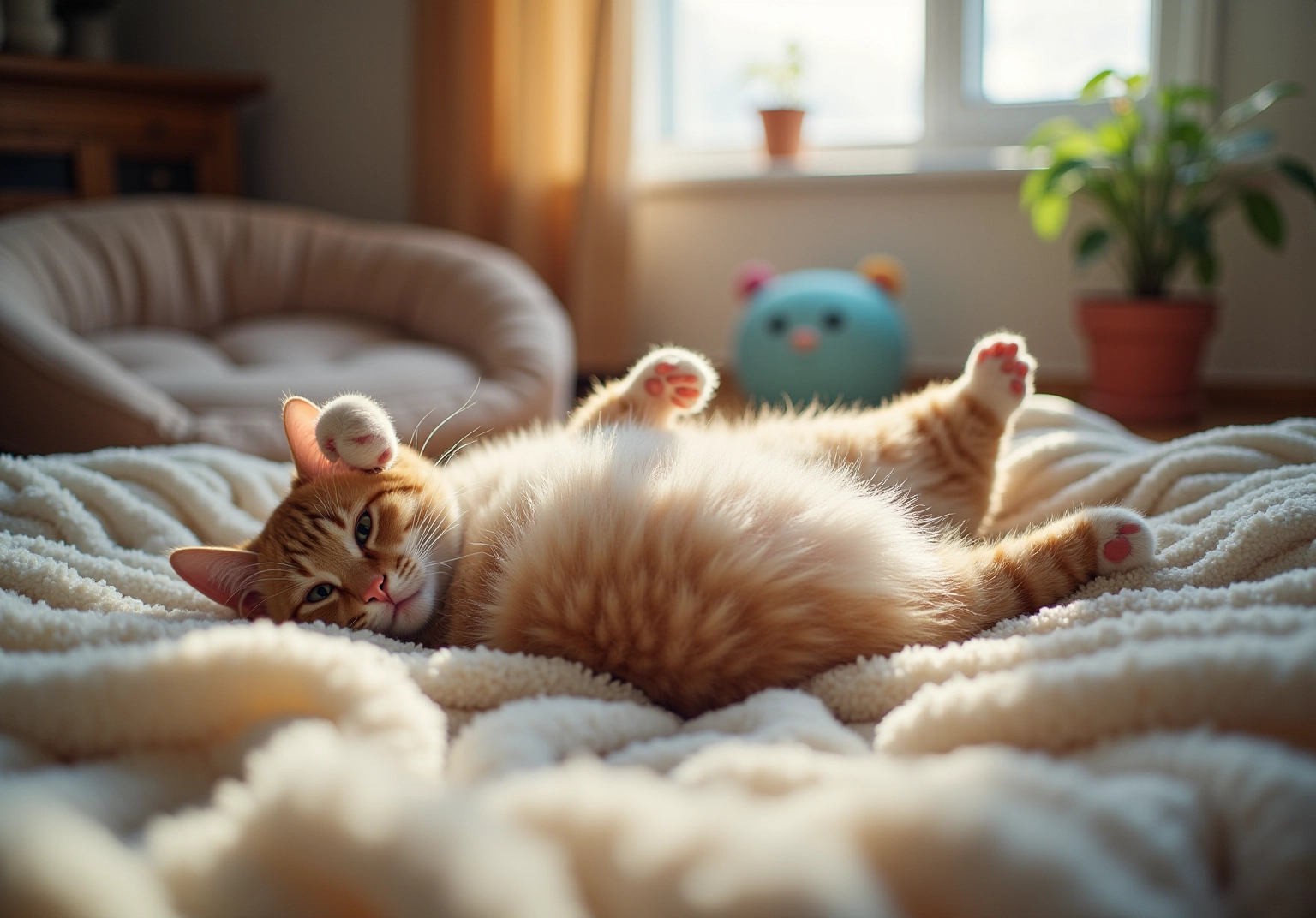
Understanding Cat Sleeping Positions Meaning for Better Care
Overview
This article delves into the meanings behind various cat sleeping positions, aiming to enhance the care we provide for our beloved pets. Each sleeping posture reflects a cat’s emotional state and comfort level. For instance, the ‘loaf’ position suggests a cat is relaxed yet alert, while the belly-up position indicates a profound sense of trust. By understanding these signals, we can create a nurturing environment that caters to the unique needs of our feline companions. It’s essential to recognize how our pets communicate their feelings through these positions, fostering a deeper bond and ensuring their well-being.
Introduction
Cats are truly remarkable creatures, and their mysterious behaviors often leave us in awe. Their sleeping positions, in particular, can tell us so much about their comfort levels and emotional states. By exploring the meanings behind these unique postures, we can gain invaluable insights into the needs and feelings of our beloved feline companions.
However, what should we consider when we notice changes in these sleeping habits? Understanding the nuances of a cat’s rest is essential, as it can help us identify potential health issues. This awareness makes it crucial for us, as caring pet owners, to pay close attention to our furry friends’ sleeping behaviors.
After all, our cats rely on us to ensure their happiness and well-being.
Define Cat Sleeping Positions
Cats have unique resting arrangements that reveal the cat sleeping positions meaning related to their comfort levels, moods, and responses to their environment. As pet owners, it’s essential to understand these behaviors, as they can provide valuable insights into our feline friends’ emotional states and overall well-being.
For example, when a cat rests on its back with its belly exposed, it shows a deep sense of safety and trust, a sentiment beautifully captured in the case study titled ‘On the Back/Belly Up.’ On the other hand, a cat curled tightly into a ball may be expressing caution or simply seeking warmth.
Did you know that cats can rest for approximately 15 to 20 hours a day? They prioritize comfort in their resting routines, which is crucial for their health. Consider the ‘Loaf’ position, where they tuck their paws and tail under their bodies; this not only helps retain body heat but also indicates a state of relaxation while remaining alert.
Cats experience various sleep stages, including REM and Non-REM sleep, contributing to their overall health. By observing these resting behaviors, we can better understand the cat sleeping positions meaning, along with our cats’ emotional health and comfort levels, ensuring we provide the best care possible.
As Emily, an editor and content marketing specialist, insightfully notes, ‘Awareness of your cat’s resting arrangement can help you understand your pet more.’ It’s also important to be mindful of any changes in your cat’s resting patterns, as these may signal potential health concerns that warrant a visit to the veterinarian.
Remember, recognizing and responding to your cat’s needs is a vital part of nurturing our beloved companions.
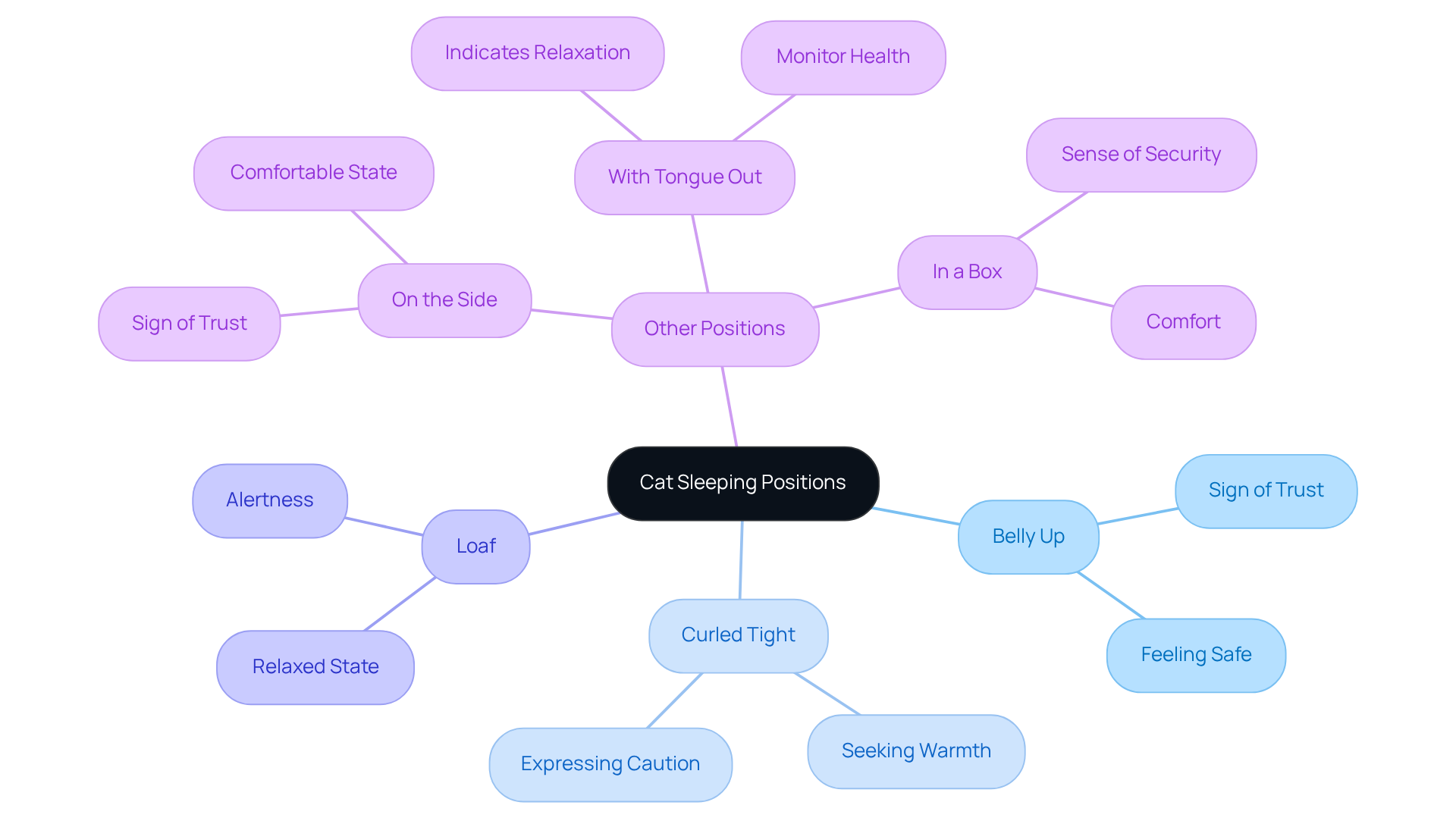
Explore the Meanings Behind Sleeping Positions
The cat sleeping positions meaning reveals so much about their emotional state and sense of security. For instance, when a cat sleeps with its paws tucked under its body, this demonstrates the cat sleeping positions meaning of feeling secure and content in a relaxed environment. However, if a cat positions itself with its back against a wall, it exhibits a defensive stance, reflecting an increased need for security.
Cats that assume the ‘loaf’ stance, with their paws tucked in, demonstrate a mix of relaxation and alertness, ready to spring into action if needed. This posture also conserves heat, allowing for quick reactions when necessary. Understanding these subtle cues, particularly the cat sleeping positions meaning, is essential for pet owners, as it empowers them to create a more comfortable and supportive environment that meets their feline companions’ emotional and physical needs.
Acknowledging that cats rest an average of 13 to 14 hours daily, observing their resting habits can offer valuable insights into their overall well-being. For instance, the cat sleeping positions meaning shows that a cat resting on its side signifies confidence and comfort, while a curled-up form reflects an instinctual need for warmth and safety. Additionally, frequent hiding can indicate stress or health issues, making it crucial for owners to monitor these behaviors.
By analyzing these resting positions, owners can better cater to their pets’ needs, ensuring a nurturing atmosphere that promotes both happiness and health.
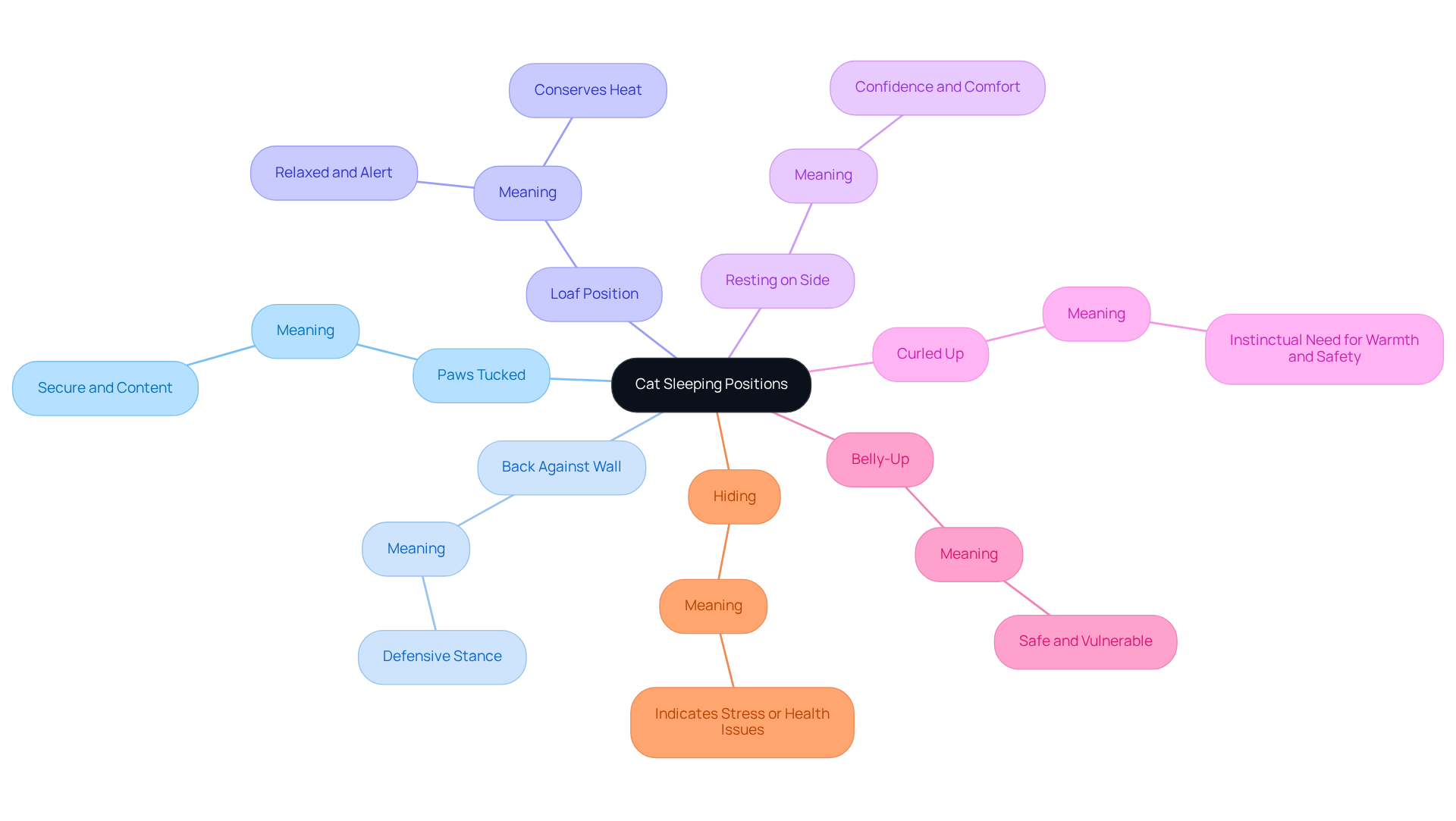
Understand Factors Influencing Cat Sleeping Habits
Understanding the cat sleeping positions meaning is essential for ensuring their well-being, as several key factors influence these patterns, including age, health, and environmental conditions. For instance, kittens require up to 20 hours of rest each day to support their growth and development. In contrast, older felines tend to rest more than they did in their youth, averaging between 16 to 20 hours due to decreased energy levels and potential health issues. It’s important to recognize that health concerns such as arthritis, hyperthyroidism, and cognitive dysfunction can disrupt a cat’s rest, leading to increased restlessness or excessive drowsiness.
Moreover, the environment plays a vital role in a cat’s ability to rest peacefully. Creating a calm and undisturbed resting area is crucial for indoor cats, as a safe space fosters restorative sleep. Conversely, a noisy or stressful atmosphere can lead to interruptions in their rest. By understanding these dynamics, pet owners can cultivate a nurturing environment that promotes healthy rest routines, ultimately enhancing their cats’ overall well-being and providing insight into cat sleeping positions meaning. Remember, your cat deserves a peaceful sanctuary, and by addressing their needs, you can help them thrive.
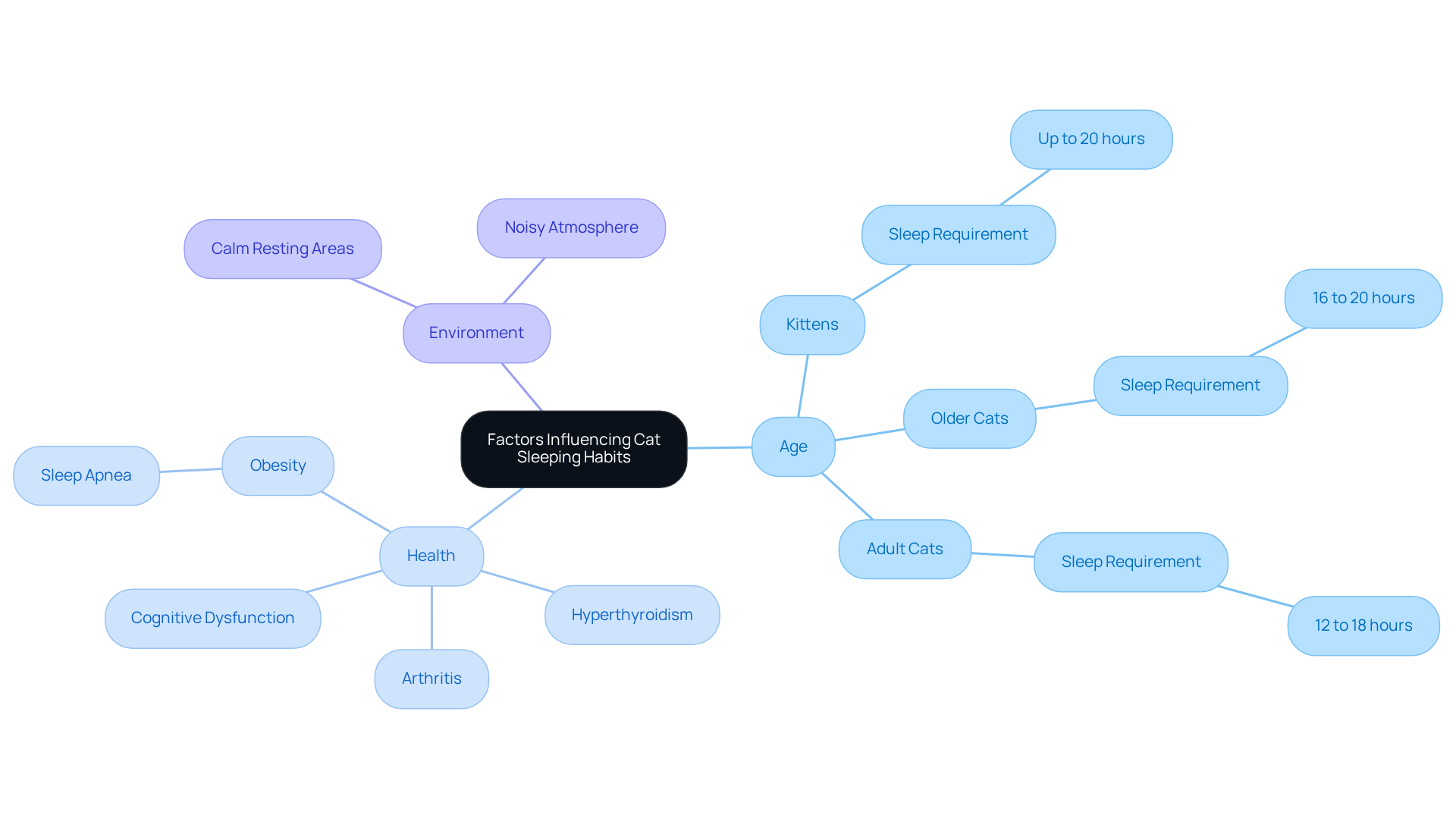
Identify Common Cat Sleeping Positions
The cat sleeping positions meaning can tell us a lot about our beloved cats’ emotional state and comfort levels. As caring pet owners, understanding these nuances allows us to provide better care and comfort for our feline companions, ensuring they feel loved and secure.
- Curled Up: When you see your cat sleeping curled up, it often indicates they are feeling a bit cold or insecure. This instinctive behavior helps them retain body heat and protect their vital organs. Typically, cats curl up into a ball with a bent neck when they are just beginning to doze off. As veterinary technician Natasha Nanji beautifully puts it, “This is your cat’s natural instinct to conserve body heat and protect its vital organs.”
- Loaf Posture: Cats that adopt the loaf posture—sitting upright with their paws tucked under their bodies—are usually relaxed yet alert. This position suggests they feel safe in their environment, while also being ready to spring into action if needed.
- Sprawled Out: A cat resting on its back with limbs extended is showing a remarkable level of comfort and trust in their surroundings. This belly-up stance exposes their most vulnerable area, indicating they feel completely secure in their space.
- Side Sleeping: When your cat sleeps on its side, it signifies deep sleep and a strong sense of security. This position allows them to fully release tension and enjoy restorative rest, reflecting their confidence in their surroundings.
- Crescent Posture: The Crescent posture, often referred to as the Tight Curl or Donut, is the most common resting stance for felines. It helps them retain body warmth and is frequently adopted during cooler conditions.
By recognizing the cat sleeping positions meaning, we can gain valuable insights into our cats’ emotional well-being, allowing us to respond appropriately to their needs and enhance their overall care. Remember, cats typically sleep between 12-18 hours a day, making it crucial for us to understand their sleeping positions to support their health and happiness.
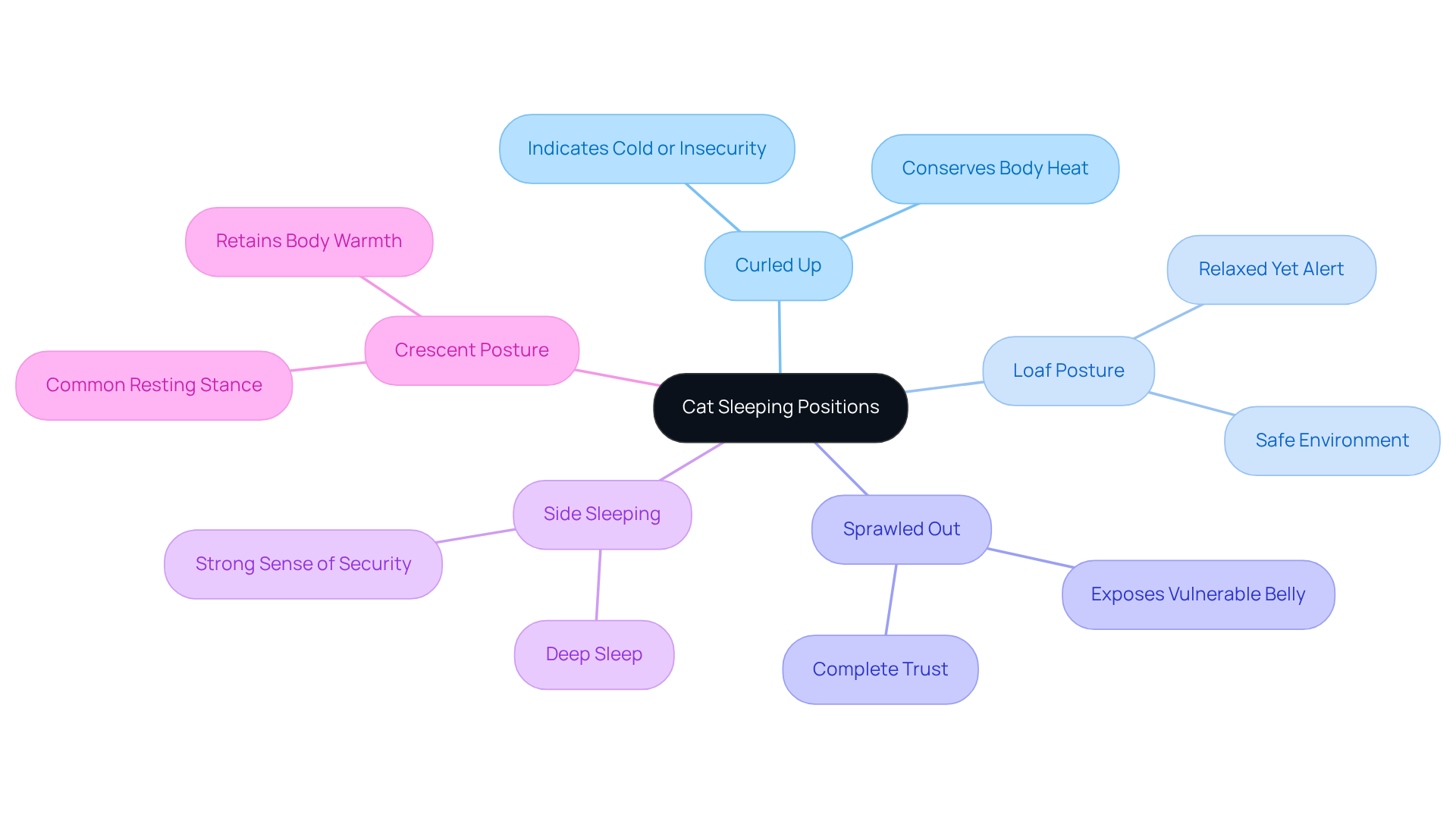
Conclusion
Understanding the nuances of cat sleeping positions offers invaluable insight into the emotional and physical well-being of our beloved pets. By recognizing how a cat’s resting posture reflects its comfort level and sense of security, we can better cater to our feline companions’ needs. Each position, from the curled-up form to the relaxed belly-up stance, communicates specific feelings and instincts, reinforcing the bond between us and our pets.
Throughout this discussion, we highlight the significance of observing these sleeping habits. For instance, a cat’s curled posture may indicate insecurity or a need for warmth, while a loaf position suggests relaxation and alertness. Additionally, factors such as age, health, and environmental conditions play a crucial role in influencing a cat’s sleeping patterns. It becomes essential for us to create a safe and nurturing atmosphere for our furry friends.
Ultimately, recognizing and interpreting cat sleeping positions not only enhances the quality of care we provide but also fosters a deeper understanding of these remarkable creatures. By paying attention to their resting behaviors, we can ensure a supportive environment that promotes both emotional and physical health, allowing our feline friends to thrive. Embracing this knowledge empowers us to nurture our pets more effectively, leading to happier, healthier lives for our cherished companions.
